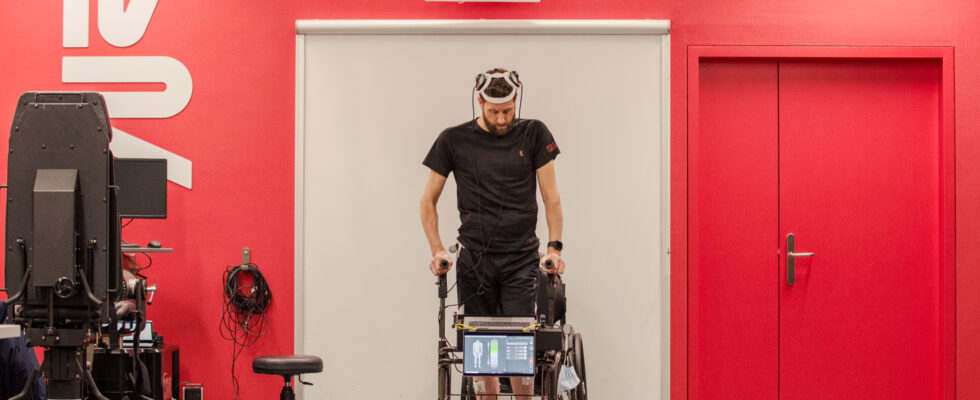A collaboration between French and Swiss researchers could enable many paralyzed people to regain the use of one or more limbs through thought.
A certain Gert-Jan, who became a paraplegic after a bicycle accident 10 years ago, was able to help teams from the CEA (Atomic Energy and Alternative Energies Commission) and EPFL (Federal Polytechnic School of Lausanne) experience a brand new device with impressive capabilities.
Sensors, an implant and algorithms
Qualified for ” digital bridge “, the device allows nothing more or less to re-establish a connection between the brain of a paralyzed patient and regions of the spinal cord that have been made inaccessible. In the case of Gert-Jan, it is a question of being able to regain the motor functions of his legs, of which he has lost control for several years.
This bridge consists of two separate devices. First, there is a sensor positioned on the patient’s head, in the region of the right and left motor cortices. It makes it possible to capture and digitize the electrical signals generated by the intention of the movement, then to send them to the second component, an implant located at the level of the spinal cord. This is a neurostimulator which, via a matrix of electrodes directly connected to the spinal cord, will be able to stimulate it to activate the leg muscles.
Unsurprisingly, since research is moving rapidly in this direction, there is a part of artificial intelligence in this whole process. Here, algorithms decode in real time the information provided by the sensors to predict the movements of the legs before converting them into sequences readable by the neurostimulator.
A true miracle of the 21st century
Within a few weeks of training after the implantation in his spinal cord, Gert-Jan was able to regain control of his legs, stand up, walk and even climb stairs. The peripheral elements of the device, including the batteries and the computer that controls the whole, have been installed in a walker, which allows it to be completely autonomous.
However, Gert-Jan’s progress didn’t stop there. Indeed, 6 months after the start of his rehabilitation, the man began to gradually recover neurological functions related to walking and balance. The coordination between brain activities and limb movements would have favored the appearance of new nerve connections, measurable even when the digital bridge is off. Although the researchers do not dwell on the subject, this could lead, one never knows, to a total or partial recovery of the control of the limbs, without assistance.
For the teams in charge of the project, it is now a question of carrying out further trials on new patients and exploring other applications such as the restoration of arm and hand movements. They could even apply the technology to other clinical indications, such as paralysis due to stroke. In addition, the development of a new version of the device, miniaturized and less energy-consuming, is already in progress with an industrialist.
It is hoped that Gert-Jan will be the first in a long line of paraplegics to regain the fullest possible use of their body. And above all, as he says himself, to be able to stand up with a friend for a beer “.
Source : ECA

5